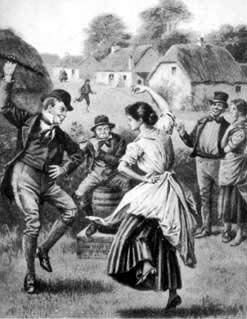Irish dancing is a central part of our culture; just like the Irish language, Gaelic football or hurling. The roots of dance in Ireland, we are told, come from the Celts and the druids’ religious rituals! It involved dancing, usually in a circular fashion around sacred trees.
It wasn’t until the 18th Century when dancing became more structured, that the styles and formations we know today came about. This was all down to the Dancing Master who travelled about holding lessons for the ordinary peasant people, often giving demonstrations on tabletops or on tops of barrels.
West Sligo is blessed with colourful descriptions of when people entertained themselves in generations past.
Sunday in Tireragh was a day of rest and religious practice – terminated after Mass, the locals being occupied with ball-playing, cake dancing and other entertainments. A dance for a cake was described by visitors and travellers who recorded their impressions. “The scene was pleasing; gentlemen and ladies on horseback and on foot, being mixed with the country people and forming a triple ring around the dancers, whilst a fellow standing on some bench or barrel held up a pole, at the end of which the cake was hung in a clean napkin, adorned with ribbons – to be given as a prize to the best performer.”
The cake, generally from eighteen to twenty inches wide, was placed on a circular board and elevated six or eight feet high but more frequently fixed on a churn-dash set upright in the ground. In Spring and Summer the cake was garnished with flowers and a piper alternately played jigs, reels and planxties. At the termination of the festivities the cake was given to the best dancer, chosen not from the elegance of style, but from the endurance of the performance.

Lady Morgan, visiting the barony of Tireragh described a ‘cake dance’ . “In the year 1806 some few halfpennies were always spared from the household purse to purchase that the Sunday cake bestowed. In the centre of a field a distaff was fixed to the earth, on which was placed a large flat cake and this cake became the reward for talent; it was sometimes carried off by the best dancer and sometimes by the archist wag of the company. The old and the young from miles around the neighbourhood hastened to enjoy the festivity. At a little distance from the standard of revelry was placed its chief agent, the piper, who was always seated on the ground and near him was dug a hole into which contributions of the assembly were dropped. At the end of each jig the piper was paid by the young who danced it and who endeavoured to enhance the value of the gift, by first bestowing it on his fair partner and although a penny a jig was esteemed very good pay, yet the gallantry or ostentation of the contributor, anxious once to appear generous in the eyes of his mistress, or to outstep the liberality of his rivals, sometimes trebled the sum which the piper usually received. It was rare to find an individual who had not for some time been under the tuition of a dancing master but the profession of this elegant art by no means prohibited the adoption if any other. A carman who was sent forth to convey some furniture ….. excused himself by saying that he was a dancing master by trade, as well as a carman and that his pupils were just so numerous he could not possibly absent himself from them.” Concludes Lady Morgan.

Another visit to the area states that dancing was considered as a necessary accomplishment and hundreds who did not know their alphabet or a word of English were regular attendants – at no small expense – at the dancing schools. Singing old Irish songs …. was part of the entertainment and many possessed sweet and melodious voices, well adapted to the melancholy and plaintive strains. In the beginning …. things were conducted with propriety, but soon the scene exhibited a chaos of tumult, vociferation and drunkenness; perhaps three musicians playing to as many sets of dancers, a dozen men and women singing different songs, whilst other groups were engaged in altercation and quarrelling.
A later reference to the cake-dance is given in W. H. Maxwell: “The Fortunes of Hector O’Halloran” London 1858 : Cakes are nightly assemblies …. And holden for the purpose of dancing, drinking and courting.
Desirous of obtaining more information on this old-time dance, the Irish Folklore Commission in July 1941 ,made contact with twenty-two correspondents in different parts of Connacht.
Cloonrover, on the Sligo/Mayo border and Cully and Cloonagh are mentioned as areas the cake-dance is carried on in folk memory but a report signed by Joseph O’Keane states that the custom had died out completely in Dromore West.
Padraic Feehily
